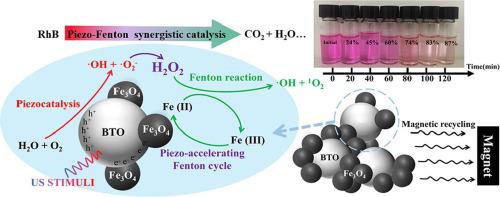当前位置:
X-MOL 学术
›
Chem. Eng. J.
›
论文详情
Our official English website, www.x-mol.net, welcomes your feedback! (Note: you will need to create a separate account there.)
Piezo-Fenton catalysis in Fe3O4-BaTiO3 nanocomposites: A low-cost and highly efficient degradation method without the additive of H2O2 or Fe(II) ions
Chemical Engineering Journal ( IF 15.1 ) Pub Date : 2024-03-24 , DOI: 10.1016/j.cej.2024.150685 Jiaxing Xie , Qun Liu , Lijuan Huang , Xingyu Chen , Chunlin Zhao , Xiao Wu , Tengfei Lin , Yong Wu , Min Gao , Cong Lin
Chemical Engineering Journal ( IF 15.1 ) Pub Date : 2024-03-24 , DOI: 10.1016/j.cej.2024.150685 Jiaxing Xie , Qun Liu , Lijuan Huang , Xingyu Chen , Chunlin Zhao , Xiao Wu , Tengfei Lin , Yong Wu , Min Gao , Cong Lin

|
The Fenton reaction, an effective advanced oxidation process (AOP) for degrading organic pollutants, requires the addition of HO that is expensive and not environmentally friendly to some extent. It has been reported that piezocatalysis can generate HO under mechanical excitation. Therefore, it is promising to carry out the Fenton catalysis utilizing HO generated by piezocatalysis. However, the current piezocatalysis-assisted Fenton (Piezo-Fenton) reaction was realized by adding piezoelectric nanoparticles and Fe(II) ions to pollutant solutions, which would induce more iron-based chemicals that are not easy to recycle. Herein, FeO-BaTiO nanocomposites were prepared to demonstrate the feasibility of piezo-Fenton catalysis without the addition of HO or Fe(II) ions. The organic dye degradation efficiency of 98.2% is obtained using FeO-BaTiO nanocomposites in the acidic solution, one-third and two-thrid greater than that of pure piezocatalysis and that of iron-based Fenton reaction, respectively. Moreover, since the piezocatalysis process is the rate-determining step of the whole piezo-Fenton reaction, all the HO generated can be consumed. Considering that the solid nanocomposites can be magnetically recycled, piezo-Fenton catalysis leaves no additional chemicals in clean water and thus provides an environmentally friendly and low-cost approach for organic dye degradation.
中文翻译:

Fe3O4-BaTiO3 纳米复合材料中的压电芬顿催化:一种无需添加 H2O2 或 Fe(II) 离子的低成本高效降解方法
芬顿反应是一种有效降解有机污染物的高级氧化过程(AOP),需要添加H2O,但价格昂贵且在一定程度上不环保。据报道,压电催化可以在机械激励下产生H2O。因此,利用压电催化产生的H2O进行Fenton催化是有希望的。然而,目前的压电催化辅助芬顿(Piezo-Fenton)反应是通过向污染物溶液中添加压电纳米粒子和Fe(II)离子来实现的,这会诱导出更多不易回收的铁基化学物质。在此,制备了 FeO-BaTiO 纳米复合材料,以证明在不添加 H2O 或 Fe(II) 离子的情况下压电芬顿催化的可行性。 FeO-BaTiO纳米复合材料在酸性溶液中有机染料的降解效率达到98.2%,分别比纯压电催化和铁基Fenton反应的降解效率高三分之一和三分之二。此外,由于压电催化过程是整个压电芬顿反应的速率决定步骤,因此产生的所有H2O都可以被消耗。考虑到固体纳米复合材料可以磁力回收,压电芬顿催化不会在干净的水中留下额外的化学物质,从而为有机染料降解提供了一种环保且低成本的方法。
更新日期:2024-03-24
中文翻译:

Fe3O4-BaTiO3 纳米复合材料中的压电芬顿催化:一种无需添加 H2O2 或 Fe(II) 离子的低成本高效降解方法
芬顿反应是一种有效降解有机污染物的高级氧化过程(AOP),需要添加H2O,但价格昂贵且在一定程度上不环保。据报道,压电催化可以在机械激励下产生H2O。因此,利用压电催化产生的H2O进行Fenton催化是有希望的。然而,目前的压电催化辅助芬顿(Piezo-Fenton)反应是通过向污染物溶液中添加压电纳米粒子和Fe(II)离子来实现的,这会诱导出更多不易回收的铁基化学物质。在此,制备了 FeO-BaTiO 纳米复合材料,以证明在不添加 H2O 或 Fe(II) 离子的情况下压电芬顿催化的可行性。 FeO-BaTiO纳米复合材料在酸性溶液中有机染料的降解效率达到98.2%,分别比纯压电催化和铁基Fenton反应的降解效率高三分之一和三分之二。此外,由于压电催化过程是整个压电芬顿反应的速率决定步骤,因此产生的所有H2O都可以被消耗。考虑到固体纳米复合材料可以磁力回收,压电芬顿催化不会在干净的水中留下额外的化学物质,从而为有机染料降解提供了一种环保且低成本的方法。



























 京公网安备 11010802027423号
京公网安备 11010802027423号